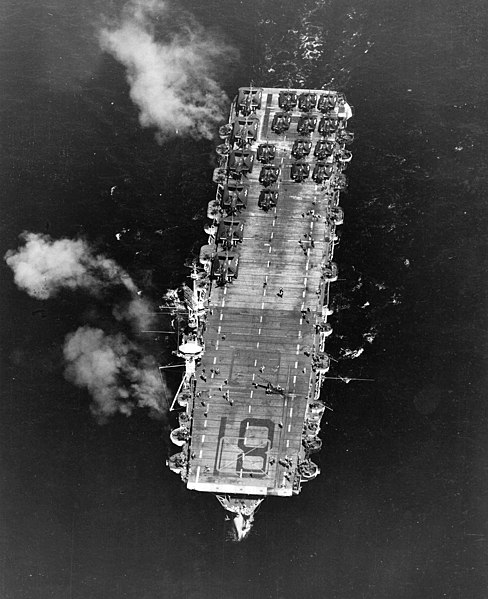USS Rudyerd Bay (CVE-81) was the twenty-seventh of fifty Casablanca-class escort carriers built for the United States Navy during World War II. She was named after Rudyerd Bay, within Ketcchikan Gateway Bourough, of the Territory of Alaska. Today, the bay lies within Misty Fjords National Monument. The ship was launched in January 1944, commissioned in February, and served as a replenishment and transport carrier throughout the Mariana and Palau Islands campaign and the Philippines campaign. Later, she served as a frontline carrier, providing air cover and support for the invasion of Iwo Jima, and the Battle of Okinawa. Postwar, she participated in Operation Magic Carpet, repatriating U.S. servicemen from throughout the Pacific. She was decommissioned in June 1946, when she was mothballed in the Atlantic Reserve Fleet. Ultimately, she was sold for scrapping in January 1960.
USS Rudyerd Bay underway, 19 July 1944. She is wearing camouflage Measure 32, Design 15a.
The fleet oiler Severn (foreground) and Rudyerd Bay (background) photographed steaming together in April 1944, before Rudyerd Bay had received its camouflage.
A radar image of Typhoon Cobra, 18 December 1944.
In an overhead shot of Rudyerd Bay on 20 May 1945, numerous aircraft of Composite Squadron 96 (VC-96), a couple of the carrier's crew, and a crane are visible.
Casablanca-class escort carrier
The Casablanca-class escort carrier was a series of escort carriers constructed for the United States Navy during World War II. They are the most numerous class of aircraft carriers ever built. Fifty were laid down, launched and commissioned within the space of less than two years – 3 November 1942 through to 8 July 1944. Despite their numbers, and the preservation of more famous and larger carriers as museums, none of these modest ships survive today. Five were lost to enemy action during World War II and the remainder were scrapped.
USS Guadalcanal, 1944
Casablanca-class escort carriers fitting out, circa April 1944.
USS Lunga Point
USS Gambier Bay under fire at Samar, 1944








